Ancient Wisdom and Modern Health in Everyday Japanese Cuisine
While the term “superfood” has a modern ring to it, traditional Japanese cuisine has long incorporated numerous foods with exceptional health benefits.
These are not rare or hard-to-obtain ingredients but are, in fact, “everyday foods” commonly found on the daily dinner table.
This article will spotlight five representative superfoods regularly consumed by Japanese people: miso, natto, tofu, nukazuke (rice bran pickles), and green tea.
The regular intake of these foods is arguably deeply connected to the health and longevity of the Japanese people.
Table of Contents
These foods are not merely nutritious; they are profoundly intertwined with traditional Japanese food culture and daily life.
They are readily available not only in home cooking but also in many common eateries, forming the very foundation of Japanese cuisine.
This article will delve into the nutritional value and health benefits of each food, incorporating scientific insights, while also highlighting their significance in Japanese food culture.
Applying the Western concept of “superfood” to these long-cherished Japanese foods is an attempt to bridge traditional wisdom with modern health consciousness.
Revisiting them from this perspective allows for a renewed appreciation of the timeless value these familiar foods hold.
The fact that these foods remain firmly rooted in the Japanese diet, even as Westernization progresses, suggests that their powerful combination of taste, health benefits, and cultural identity allows them to retain their significance in a changing culinary landscape.
II. The 5 Japanese Superfoods: Their Nutrition and Benefits
Let’s take a closer look at the nutrients and specific benefits of five “superfoods” selected from the traditional foods that grace the Japanese table, chosen for their high nutritional value and everyday consumption.
A. Miso: The Healing Power of Fermentation
What is Miso
Miso is a traditional Japanese seasoning made by fermenting soybeans with salt and koji (a culture typically made from rice, barley, or soybeans).
It’s an indispensable ingredient in many Japanese dishes, starting with miso soup, and has supported the Japanese diet for centuries with its flavor and high nutritional value.
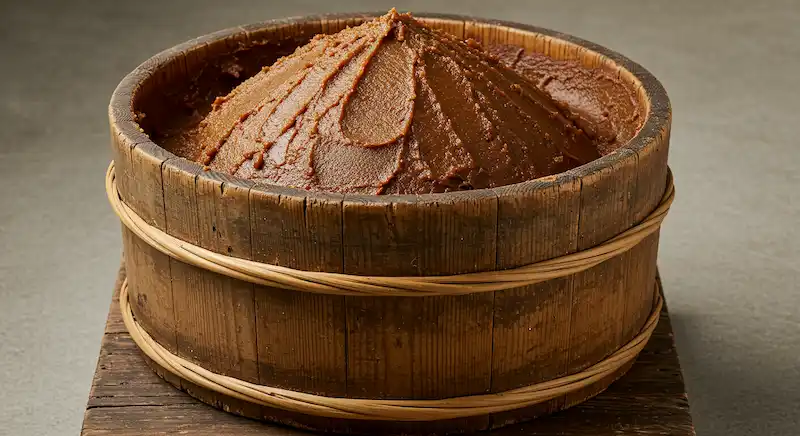
- Main Nutrients
Miso is rich in various nutrients produced during fermentation.- Protein and Essential Amino Acids
Soybeans, the main ingredient, are known as “meat of the fields,” providing high-quality plant-based protein.
Miso contains a good balance of essential amino acids that the body cannot synthesize. - Vitamins
Abundant in B vitamins (especially B2, B6) that aid energy metabolism, and antioxidant vitamin E. - Minerals
Contains various minerals essential for maintaining health. - Dietary Fiber: Includes dietary fiber that helps regulate the gut environment.
- Probiotics and Enzymes
Being a fermented food, it contains lactic acid bacteria and yeast that support gut health, as well as enzymes that aid digestion. - Isoflavones and Lecithin
Soy-derived compounds with various expected health benefits. - Free Linoleic Acid: Noted by research from Japan’s Ministry of Agriculture, Forestry and Fisheries (MAFF) for its potential role in skin whitening.
- Protein and Essential Amino Acids
- Specific Benefits
- Improved Digestion
Probiotics and dietary fiber balance intestinal bacteria, improve bowel movements, and aid digestion. - Cholesterol Reduction
Soy lecithin and dietary fiber may help suppress cholesterol absorption and promote its excretion. - Antioxidant Effects
Polyphenols, vitamin E, and isoflavones combat oxidation in the body, potentially helping prevent cancer, lifestyle-related diseases, and aging. - Skin Brightening/Whitening
Free linoleic acid in miso is believed to inhibit melanin production, potentially preventing spots and freckles and offering a whitening effect
Research from MAFF’s National Food Research Institute has suggested this, and the old saying “the hands of those involved in miso-making are white” might support this effect. - Immune Boost
Probiotics and various nutrients contribute to enhancing immune function. - Potential Cancer Prevention
Epidemiological studies by the late Dr. Takeshi Hirayama and others at the National Cancer Center Research Institute reported a lower mortality rate from stomach cancer among those who drank miso soup daily.
It also suggested that even smokers might reduce their stomach cancer risk by drinking miso soup every day. - Blood Pressure Regulation
Peptides produced during fermentation are being researched for their potential blood pressure-lowering effects. - Potential Radiation Damage Mitigation
Practices by Dr. Shinichiro Akizuki, an atomic bomb survivor physician in Nagasaki, and research at Hiroshima University (in mice) suggest that miso may help excrete radioactive substances and reduce radiation-induced gastrointestinal damage, though further research is needed.
- Improved Digestion
Interestingly, miso exhibits what could be called a “miso paradox.”
While miso is high in salt (about 1.2-1.5g per bowl of miso soup), raising concerns about hypertension risk, numerous health benefits like blood pressure reduction and reduced stomach cancer risk have been reported.
This suggests that beneficial compounds created during fermentation—such as probiotics, peptides, and melanoidins (brown pigments from Maillard reaction with antioxidant properties)—may mitigate or outweigh the negative aspects of salt.
When consumed as part of a traditional Japanese diet, these components are thought to act synergistically.
Learn more about miso here: Not Just for Miso Soup! A Deep Dive into Miso
Main Nutrients and Expected Benefits of Miso
| Main Nutrients | Expected Main Benefits |
|---|---|
| Protein, Essential Amino Acids, B Vitamins (B2, B6), Vitamin E, Dietary Fiber, Probiotics, Isoflavones, Lecithin, Free Linoleic Acid | Improved digestion, cholesterol reduction, antioxidant effects (cancer/lifestyle disease prevention, anti-aging), skin brightening, immune boost, blood pressure regulation, potential radiation damage mitigation |
B. Natto: The Unique Power of Fermented Soybeans
What is Natto?
Natto is a traditional Japanese food made by fermenting steamed soybeans with Bacillus subtilis var. natto (natto bacteria).
It has a characteristic sticky texture and aroma and is often eaten with rice, typically seasoned with mustard, soy sauce, and green onions.
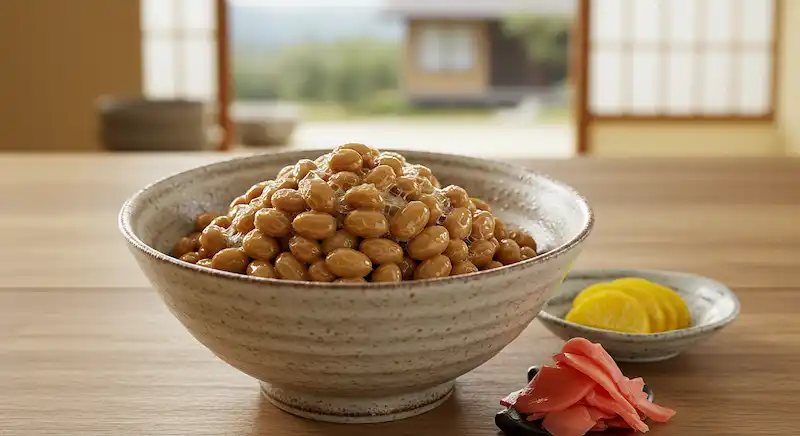
- Main Nutrients
Natto is rich in soy-derived nutrients plus unique compounds produced by fermentation.- Nattokinase
A unique enzyme found in natto’s sticky strings, produced by natto bacteria during fermentation. - Vitamin K2 (Menaquinone-7)
Natto is one of the richest food sources of Vitamin K2. - Protein
High-quality soy protein with an amino acid score of 100. - Dietary Fiber
Contains both soluble and insoluble dietary fiber. - Soy Isoflavones
Soy-derived phytoestrogens. - Minerals
Rich in iron, calcium, magnesium, and potassium. - Vitamins
Includes B vitamins (B1, B2, B6) and vitamin E. - Natto Bacteria
The live bacteria responsible for fermentation. - Lecithin, Saponins, Polyamines
Other beneficial compounds from soy or fermentation.
- Nattokinase
- Specific Benefits
- Cardiovascular Health
Nattokinase is believed to have thrombolytic (blood-thinning) effects, promoting healthy blood flow and potentially lowering blood pressure.
Lecithin aids in cholesterol management. - Bone Health
Abundant Vitamin K2 plays a crucial role in osteoporosis prevention by helping deposit calcium into bones.
Synergistic effects are expected when consumed with calcium. - Improved Digestion
Dietary fiber and natto bacteria regulate the gut environment, promote digestion, and alleviate constipation. - Immune Boost
A healthy gut flora contributes to a stronger immune system. - Beauty and Anti-aging
Protein, B vitamins, vitamin E, and isoflavones contribute to healthy skin and hair.
Isoflavones are also said to help alleviate menopausal symptoms. - Blood Sugar Regulation
Dietary fiber is expected to moderate sugar absorption. - Mental Stability
Contains tryptophan, a precursor to serotonin, potentially contributing to mental well-being.
- Cardiovascular Health
The powerful combination of nattokinase and vitamin K2 in natto offers a unique synergistic benefit for comprehensive cardiovascular and bone health rarely found in a single food source.
While nattokinase is primarily associated with dissolving blood clots and improving blood flow, vitamin K2 is crucial for directing calcium to bones and preventing its deposition in arteries.
Healthy circulation (from nattokinase) and proper calcium metabolism (from vitamin K2) are both vital for cardiovascular health.
Strong bones (from vitamin K2) also benefit from good nutrient delivery via healthy blood flow.
This positions natto not just as a source of protein and fiber, but as a functional food with specific health-promoting effects.
Furthermore, natto’s cultural journey from a sensorily challenging food for some (“Many Japanese people dislike it because of its strange smell”) to a nationally recognized health food, often dubbed a “superfood,” indicates a societal shift prioritizing health benefits over initial sensory hurdles, or perhaps an acquired taste spurred by its reputed advantages.
Learn more about natto: Why Is Natto Considered a Superfood in Japan? Health Benefits Explained
Main Nutrients and Expected Benefits of Natto
| Main Nutrients | Expected Main Benefits |
|---|---|
| Nattokinase, Vitamin K2, Protein (Amino Acid Score 100), Dietary Fiber (Soluble & Insoluble), Soy Isoflavones, B Vitamins, Vitamin E, Minerals (Iron, Calcium, etc.), Natto Bacteria, Lecithin, Saponins, Polyamines | Blood-thinning effect (clot prevention, blood pressure regulation), osteoporosis prevention, improved digestion (constipation relief), immune boost, skin/hair health, menopausal symptom relief, blood sugar control, mental stability |
C. Tofu: The Versatile King of Plant-Based Protein
What is Tofu?
Tofu is a soy product made by coagulating soy milk (traditionally with nigari – magnesium chloride, or other coagulants) and pressing the curds.
There are various types depending on the manufacturing method, such as silken tofu (kinugoshi) and firm tofu (momen), each with different textures and uses.
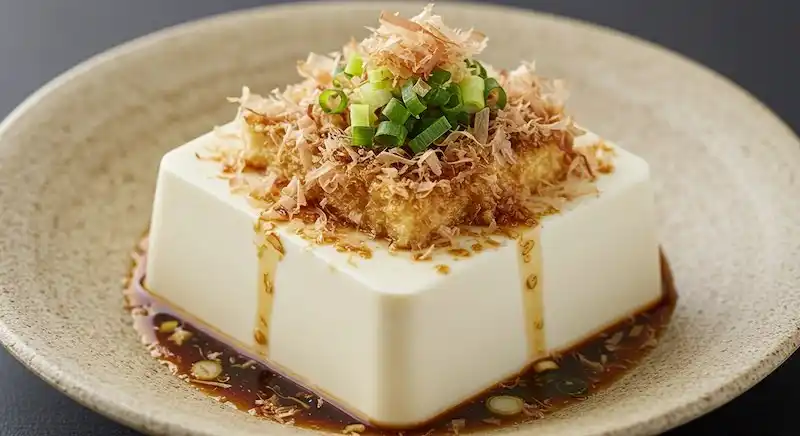
- Main Nutrients
Made from soybeans, often called “meat of the fields,” tofu contains many nutrients, including high-quality protein.- High-Quality Protein
Rich in plant-based protein with an amino acid score of 100, containing a good balance of essential amino acids. - Soy Isoflavones
A type of polyphenol that has estrogen-like effects. - Minerals
Contains calcium (especially abundant in firm tofu), iron, and magnesium. - Healthy Fats
Contains unsaturated fatty acids like linoleic acid and no cholesterol. - Low Calorie
Relatively low in calories, making it suitable for diets. - Oligosaccharides
Serve as food for beneficial gut bacteria, expected to improve the gut environment. - Lecithin, Saponins
Also contains these functional components unique to soybeans.
- High-Quality Protein
- Specific Benefits
- Muscle Maintenance/Growth
High-quality protein serves as building material for muscles, supporting strength training and dieting. - Bone Health
Calcium and soy isoflavones are said to help maintain bone density and prevent osteoporosis. - Cardiovascular Health
Plant-based protein, healthy fats, and isoflavones may help regulate blood cholesterol levels, potentially leading to the prevention of lifestyle-related diseases. - Alleviation of Menopausal Symptoms
Soy isoflavones are expected to balance female hormones and ease discomforts of menopause. - Improved Digestion
Soy oligosaccharides improve the gut environment and help with constipation. - Diabetes Prevention/Management
It is low GI, and its protein is thought to contribute to blood sugar stability. - Anemia Prevention
Can supplement iron intake.
- Muscle Maintenance/Growth
Tofu’s designation as a “natural supplement” and its central role as a plant-based protein source in the traditional Japanese diet is particularly significant considering Japan’s historically lower red meat consumption compared to Western diets.
Its versatility, from being an ingredient in miso soup to main dishes like hiyayakko (chilled tofu) and agedashi tofu (deep-fried tofu), has allowed it to remain a staple even as dietary preferences change.
The difference between firm (momen) and silken (kinugoshi) tofu extends beyond texture to nutritional value (e.g., firm tofu, being less watery and more pressed, often contains more protein and calcium than silken tofu).
This variety allows for tailored use according to culinary and nutritional goals, showcasing a sophisticated utilization of a single raw material, the soybean.
Learn more about tofu: Why Is Tofu a Staple in Japanese Cuisine? Health Benefits and Traditions
Main Nutrients and Expected Benefits of Tofu
| Main Nutrients | Expected Main Benefits |
|---|---|
| Protein (Amino Acid Score 100), Soy Isoflavones, Calcium, Iron, Magnesium, Linoleic Acid, Oligosaccharides, Lecithin, Saponins | Muscle maintenance/growth, osteoporosis prevention, cholesterol regulation (lifestyle disease prevention), menopausal symptom relief, improved digestion, anemia prevention, blood sugar stability (diabetes prevention) |
D. Nukazuke: Probiotic-Rich Fermented Goodness
What is Nukazuke?
Nukazuke are traditional Japanese pickles made by pickling vegetables in a nukadoko – a fermented bed of rice bran, salt, and water.
It’s sometimes flavored with kelp or chili peppers.
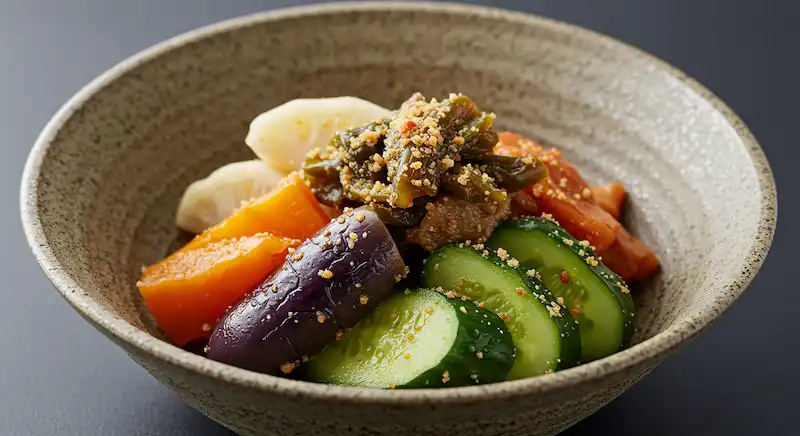
- Main Nutrients
Nukazuke becomes more nutritious through fermentation, with the following nutrients being particularly noteworthy:- Live Probiotics (Plant-Based Lactic Acid Bacteria)
Generated in large quantities through fermentation, contributing to improved gut health. - Vitamins
Vitamin B1 from vegetables significantly increases (reportedly 5-10 times for cucumbers) compared to raw vegetables.
Also contains Vitamin B2 and Vitamin E. - Enzymes
Produced by fermentation, aiding digestion. - Dietary Fiber
Rich in vegetable-derived dietary fiber. - Minerals
Minerals from the vegetables are retained.
- Live Probiotics (Plant-Based Lactic Acid Bacteria)
- Specific Benefits
- Improved Gut Environment
Abundant plant-based lactic acid bacteria regulate gut flora, aid digestion, and relieve constipation. - Immune Boost
A healthy gut environment is essential for strengthening the immune system. - Increased Nutrient Absorption
Fermentation makes nutrients more easily absorbed by the body, and vitamins like B1 from the rice bran transfer to the vegetables, enhancing their nutritional value. - Skin Benefits
Antioxidants like Vitamin E and the effects of an improved gut environment are said to contribute to skin health.
There’s also anecdotal evidence that hands become smoother from tending to the nukadoko. - Metabolism Boost
Vitamin B1 aids carbohydrate metabolism, and Vitamin B2 aids fat metabolism. - Potential Anti-Allergy and Fatigue Recovery Effects
Expected due to the action of potent plant-based lactic acid bacteria.
- Improved Gut Environment
Nukazuke is truly a symbol of living food culture.
The nukadoko (rice bran bed) is a dynamic ecosystem that, when tended daily, maintains a microbial balance and imparts unique flavor and nutritional value to vegetables.
This process elevates mere vegetables into probiotic and vitamin-rich foods.
The act of tending a nukadoko connects households to a continuous, living food process.
The declining culture of homemade pickles in recent years might signify a loss of this intimate connection with food.
The plant-based lactic acid bacteria in nukazuke, having thrived in the harsh, high-salt environment of the nukadoko, are said to be robust enough to survive within the human digestive tract.
This unique hardiness suggests they may offer superior benefits compared to other probiotic sources.
Main Nutrients and Expected Benefits of Nukazuke
| Main Nutrients | Expected Main Benefits |
|---|---|
| Plant-Based Lactic Acid Bacteria, Vitamin B1 (significantly increased in some vegetables), Vitamin B2, Vitamin E, Enzymes, Dietary Fiber | Improved digestion (constipation relief, gut environment improvement), immune boost, skin benefits, fatigue recovery, potential allergy prevention, carbohydrate & fat metabolism boost |
E. Green Tea: An All-Purpose Beverage Rich in Antioxidants
What is Green Tea?
Green tea is made from the leaves of Camellia sinensis, an evergreen tree of the Theaceae family, and is produced without fermentation.
It’s an extremely popular beverage in Japan, consumed daily by many.
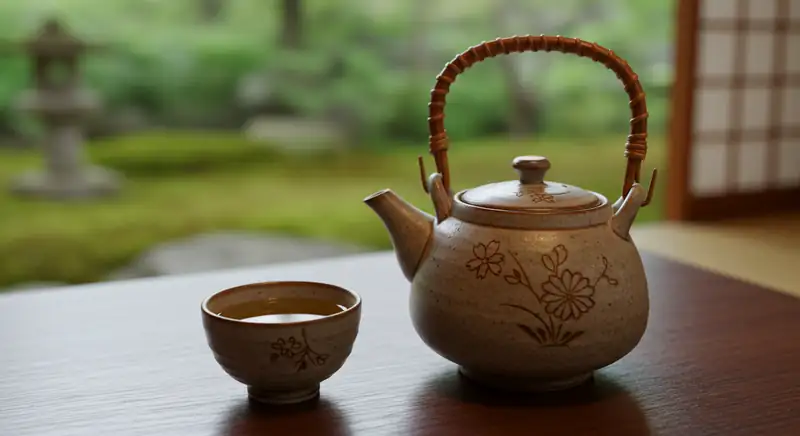
- Main Nutrients
Green tea contains various beneficial compounds- Catechins (especially EGCG)
Powerful antioxidants responsible for many of green tea’s health benefits and its characteristic astringency. - L-Theanine
An amino acid that promotes relaxation and improves concentration. - Caffeine
Provides a mild stimulating effect. - Vitamins
Includes Vitamin C, B-group vitamins, and Vitamin E. - Minerals
Contains fluoride, potassium, and calcium. - Flavonoids, Saponins, GABA
Other beneficial compounds.
- Catechins (especially EGCG)
- Specific Benefits
- Powerful Antioxidant Action
Catechins scavenge free radicals, protecting the body from cell damage, aging, and lifestyle-related diseases. Vitamin E also contributes to this action. - Potential Cancer Prevention
Catechins are being researched for their potential to inhibit cancer cell growth and reduce cancer risk. - Cardiovascular Health
May help lower cholesterol levels and blood pressure, and improve vascular function. - Cognitive Support
L-theanine and caffeine are expected to enhance attention, mood, and cognitive abilities. - Oral Hygiene
The antibacterial action of catechins inhibits the growth of bacteria that cause cavities and bad breath. Fluoride also strengthens teeth. - Weight Management Support
May slightly increase metabolism and promote fat burning. - Stress Reduction & Relaxation
L-theanine increases alpha waves in the brain, inducing a state of calm alertness. - Anti-inflammatory & Anti-allergic Effects
Certain components like catechins and methylated catechins (found in varieties like ‘Benifuuki’) have reported anti-inflammatory and anti-allergic properties. - Blood Sugar Regulation
May help control blood sugar levels.
- Powerful Antioxidant Action
The Japanese custom of drinking green tea after meals, especially its provision as “agari” in sushi restaurants, is not merely tradition but is supported by scientific understanding of its benefits, such as oral hygiene and aiding digestion (by resetting the palate).
This illustrates intuitive or empirically derived health practices embedded within cultural norms.
The diverse compounds in green tea (antioxidant/anti-cancer catechins, relaxing L-theanine, stimulating caffeine, etc.) offer a unique “calm alertness” and broad health benefits beyond simple hydration.
This complexity makes green tea an unparalleled “super-beverage” in Japanese culture, integral to both physical health and mental well-being.
Learn more about green tea: Why Japanese Tea Could Be Your Next Healthy Choice
Main Nutrients and Expected Benefits of Green Tea
| Main Nutrients | Expected Main Benefits |
|---|---|
| Catechins (EGCG, etc.), L-Theanine, Caffeine, Vitamin C, B Vitamins, Vitamin E, Fluoride, Minerals, Flavonoids, Saponins, GABA | Powerful antioxidant action (cancer/lifestyle disease prevention, anti-aging), cholesterol/blood pressure regulation, cognitive support, oral hygiene (cavity/bad breath prevention), diet support, stress reduction/relaxation, anti-inflammatory/anti-allergic effects, blood sugar regulation |
III. Superfoods Woven into Daily Life: Everyday Japanese Meals and Traditional Food Culture
These superfoods are not just nutritionally dense; they are deeply rooted in daily Japanese eating habits and traditional food culture.
But that’s not all: Other Japanese superfoods
A. “Ichiju-Sansai”
The Basic Form of a Japanese Meal The traditional Japanese meal is based on “Ichiju-Sansai” (one soup, three side dishes), accompanied by rice (the staple) and konomono (pickles).
- Miso soup is the quintessential “soup,” often containing ingredients like tofu and wakame seaweed, boosting its nutritional value.
- Tofu frequently appears as a main dish, like hiyayakko (chilled tofu) or agedashi tofu (deep-fried tofu), or as a component of various side dishes.
- Pickles like nukazuke serve as konomono, adding flavor, textural contrast, and aiding digestion.
This “Ichiju-Sansai” meal structure is designed for nutritional balance and variety.
The consistent inclusion of miso soup (fermented soy, vegetables, seaweed), pickles (fermented vegetables, probiotics), and often tofu (plant-based protein) within this framework demonstrates a long-standing cultural understanding of a balanced, gut-friendly diet that predates modern nutritional science’s emphasis on these aspects.
B. Integration into the Dining Table: Everyday Staples
On the typical Japanese family table, especially for breakfast, it’s not uncommon to find at least one, and often several, of these five superfoods.
A traditional Japanese breakfast often consists of rice, miso soup, grilled fish, natto, pickles, and a cup of green tea, itself showcasing the daily integration of these superfoods.
These items are not just for special occasions but are part of the daily rhythm of eating.
C. Deep Roots in History and Culture
Miso, tofu, and tea are said to have been introduced to Japan around the Kamakura period (1185-1333) along with the spread of Zen Buddhism and shojin ryori (Buddhist vegetarian cuisine).
Natto has ancient origins with various regional legends.
Nukazuke developed as a way to preserve vegetables and utilize rice bran, becoming widespread during the Edo period (1603-1868).
These foods have been refined over centuries, becoming integral to Japanese identity and regional food cultures.
The fact that these five distinct foods – a fermented paste, fermented whole soybeans, coagulated soy, rice-bran fermented vegetables, and processed tea leaves – all derive from relatively simple agricultural products (soybeans, rice bran, tea leaves, vegetables) points to a sophisticated and resourceful food processing tradition in Japan.
This tradition maximizes nutritional value, preservation, and flavor diversity from basic ingredients.
Moreover, regional variations in these foods, such as different types of miso or local pickles, reflect a deep connection to local agriculture, climate, and culinary preferences.
While they are national “superfoods,” their expression can be very local, adding further depth to Japan’s rich food culture.
D. Consumption Trends and the Modern Situation
While these foods are traditional pillars, modern dietary habits are evolving.
Some data suggest a decline in the consumption frequency of certain traditional foods like miso and pickles, particularly among younger generations and due to the Westernization of diets.
However, due to a growing health consciousness, they continue to be highly valued and, in some cases, are experiencing a resurgence in popularity.
For instance, natto consumption remains high, and green tea is widely consumed in various forms.
This article aims to reconfirm the value of these traditional superfoods in the modern era.
IV. Familiar Superfoods Even Outside the Home: Availability in Everyday Eateries
These five superfoods are not only staples at home but are also served in many common Japanese restaurants, making them very easy to consume.
A. Izakaya (Japanese Pubs)
- Miso Soup
Sometimes offered as part of a set meal or as a final dish. - Tofu
Chilled tofu (hiyayakko), deep-fried tofu (agedashi tofu), and boiled tofu (yudofu) are popular.
Menu items like “Special Meat Miso Tofu” (at Mirai Zaka) can also be found. - Pickles
Served as an assortment (tsukemono moriawase), which may include nukazuke. - Natto
Offered in some establishments as a creative dish or a simple side. - Green Tea
Served as a soft drink or in alcoholic beverages like ocha-wari (shochu with green tea, or “green tea high”).
B. Kaiten-zushi (Conveyor Belt Sushi Restaurants)
- Green Tea
Self-service powdered tea (agari) is common and essential for cleansing the palate between different types of sushi.
Sometimes offered in bottles. - Miso Soup
A standard side menu item, often with clams or aosa seaweed. - Natto:
Widely available as natto maki (natto rolls) or natto gunkan (natto battleship sushi). - Tofu
Found as an ingredient in miso soup or inarizushi (sushi rice in seasoned deep-fried tofu pouches).
Some chains may offer chilled tofu as a side. - Pickles
Gari (pickled ginger) is always provided, and kappa maki (cucumber pickle rolls) are a staple.
C. Gyudon-ya (Beef Bowl Shops) & Major Chain Teishoku-ya (Set Meal Restaurants)
- Miso Soup
A standard accompaniment to beef bowls and set meals. - Pickles
Served as oshinko (pickles) with beef bowls and set meals.
Yoshinoya’s oshinko are koji-pickled. - Natto
A staple, especially in breakfast sets, and also available as a standalone item. - Tofu
Offered as chilled tofu, either standalone or as part of a set meal. Yoshinoya previously had menu items like “Tofu Bukkake Meshi” (tofu over rice). - Green Tea
Offered as a standard beverage, either free or for a charge.
The consistent availability of miso soup, pickles, and green tea across such diverse and affordable eateries as izakayas, conveyor belt sushi restaurants, and beef bowl/set meal chains underscores their status as fundamental, non-negotiable elements of the dining experience for the general Japanese populace, transcending specific cuisine types.
Their presence is expected and catered to.
Tofu and natto, while highly nutritious and traditional, have a more contextual presence in these establishments.
Tofu is very common in izakayas (chilled, fried) and set meal restaurants (as a side dish) but less prominent as a primary offering in sushi or beef bowl shops (except as a miso soup ingredient or in specific breakfast sets).
Natto is a fixture in breakfast sets at beef bowl/set meal places and as natto maki in sushi restaurants, but less so as a main menu item in izakayas.
This suggests that while their health value is recognized, their incorporation into out-of-home dining menus is often tied to specific meal types (e.g., breakfast) or dish formats (e.g., sushi rolls, appetizers).
Availability of Superfoods in Major Eateries
| Food | Izakaya (Pubs) | Conveyor Belt Sushi | Beef Bowl Shops | Major Chain Set Meal Restaurants |
| Miso/Miso Soup | ✓ (Standalone, part of set) | ✓ (Standard side, e.g., clam, aosa) | ✓ (Standard with meal or option) | ✓ (Standard with set meal or option) |
| Natto/Natto Dishes | △ (Creative dishes, some places) | ✓ (Natto rolls/gunkan are standard) | ✓ (Breakfast sets, standalone) | ✓ (Breakfast sets, standalone) |
| Tofu/Tofu Dishes | ✓ (Chilled, fried, etc.) | △ (Miso soup ingredient, inari, some sides) | ✓ (Chilled tofu (standalone), some breakfast) | ✓ (Chilled tofu (standalone), small dish in set) |
| Nukazuke/Other Pickles | ✓ (Pickle assortments, etc.) | ✓ (Gari always provided, kappa maki) | ✓ (Oshinko with meal/standalone) | ✓ (With set meal, standalone) |
| Green Tea | ✓ (Soft drink, tea cocktails) | ✓ (Agari, usually free) | ✓ (Standard drink menu) | ✓ (Drink bar, standalone) |
(✓: Generally available, △: Sometimes/in specific forms)
Carrying the Tradition of Japanese Superfoods into a Healthy Future
Miso, natto, tofu, nukazuke, and green tea.
With their rich array of nutrients – proteins, vitamins, minerals, dietary fiber, probiotics, and antioxidants – and their unique health-promoting effects, these five foods can truly be called Japan’s pride-worthy “superfoods.”
These foods are not merely high in nutritional value; they form the bedrock of Japan’s traditional healthy dietary lifestyle and are deeply and widely integrated into Japanese food culture, from the family dinner table to everyday eateries.
The traditional “Ichiju-Sansai” meal style is an ideal framework for naturally incorporating these superfoods, and their combination is exceptionally well-balanced from a nutritional standpoint.
The modern “superfood” boom often directs attention to expensive and novel ingredients.
However, the scientifically supported benefits of these traditional Japanese foods, along with their accessibility, affordability, and cultural familiarity, offer us incredibly valuable choices.
Consciously incorporating these familiar superfoods into our daily diet holds significant meaning not only for maintaining health but also for passing on a rich food culture to the next generation.
Consuming these five foods not just individually but in combination within traditional Japanese dietary patterns may yield synergistic effects that have contributed to Japanese longevity. An “Ichiju-Sansai” meal often features several of these foods, providing an opportunity to consume diverse nutrients and beneficial fermented products simultaneously.
This holistic approach is indeed the wisdom of Japanese food culture.
Incorporating these traditional superfoods into our daily lives and enjoying their benefits should be a simple yet powerful step towards building our own healthy future.
Reference site
- Ministry of Agriculture: What are the benefits of pickling vegetables?
- Ministry of Agriculture: Supporting the Japanese dining table together | Tea

